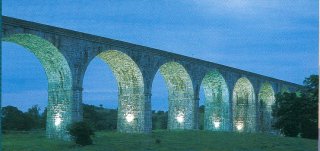This Tourist Brochure differs little from its c.1994 predecessor. Anthony Russell has been brought on board to lend some historical and literary credence but it must be acknowledged that the misuse of the comma persists and still irks.
His descriptions of the principal Trail Stops [29 on The Long Trail and 18 on The Short Trail] are interesting and accurate. I confess that the overall effect still leaves me cold. These Trails celebrate the middle class commercial and industrial, largely Protestant and English or Planter residents of yesteryear. The Long Trail diverts temporarily into Ballybot (Poor Town) but seemingly to laud the brewers and distillers and Establishment figures who once lived there. The majority of Newry residents past and present are of the native Irish and Catholic tradition, as of course are most of those who produced this booklet and most ex-patriate tourists, who constitute a very significant fraction of our visitors. Americans in particular might be impressed with a town that has known perhaps a thousand years of continuous human habitation (the coming of the Cistertians in 1144 and the granting of a royal charter soon after was not, as so often portrayed, the beginning for this site) and perplexed that this heritage trail portrays only the latter half of this time, since the English occupiers reigned supreme.
Closer to the present day, surely visitors will – if only in passing – enquire after the plethora of Republican monuments (e.g. at Kilmorey Street and Fisher Park) that have recently appeared. One does not have to approve to express curiosity. The truth is that we are no longer a garrison town. This needs to be said.
A few anomalies grate. Some of us regret that ‘the stump of an old distillery chimney can be seen at the junction of the Dromalane Road’ is no longer so but is now a Quays car park (Why?). Indeed this was removed before the brochure went to press. Worse, Newry Court House which is herein extolled (complete with photograph) was long replaced by the modern building.
I started to read the section NEWRY – A SHORT HISTORY but baulked at the first line. “The first recorded footsteps in the Clanrye Valley were those of St Patrick..”. This is patently not so, as the historian well knows. The revisionist author has decided to purge the whole pre-Christian Gaelic Order. Why, one wonders, is this later translated into Irish, the language of the people Patrick came to convert?
The whole work has a British spin. I thought I was being paranoic until I noticed that the SHORT HISTORY had been lifted complete from the earlier brochure, with the notable ‘correction’ that the earlier term ‘Britain and Ireland’ had become ‘British Isles’ [describing our canal as the first in ..]. The ‘spin’ continues to the grand finale. Apparantly the 1970s, despite the Troubles, saw an injection of public capital that greatly improved communications.
Can you believe this? We suffer from the worst traffic jams of the worst road network infrastructure on the east coast; a whistlestop railway station two miles from town where the occasional inter-city train halts temporarily; and of course no airport. Doesn’t the tourist you are addressing – who has arrived here despite all this – know that too? Among many other things our Troubles were marked especially by an enormous shift of essential public resources to security [the two most impressive and expensive buildings are Ardmore Police Station and the Courthouse].
This expensive fold-up brochure is out of date already. This negates its many fine features. Why doesn’t someone in Council administration check and correct such errors before landing the ratepayer with outlandish bills? Over to you, Mr McGivern (I think!).
